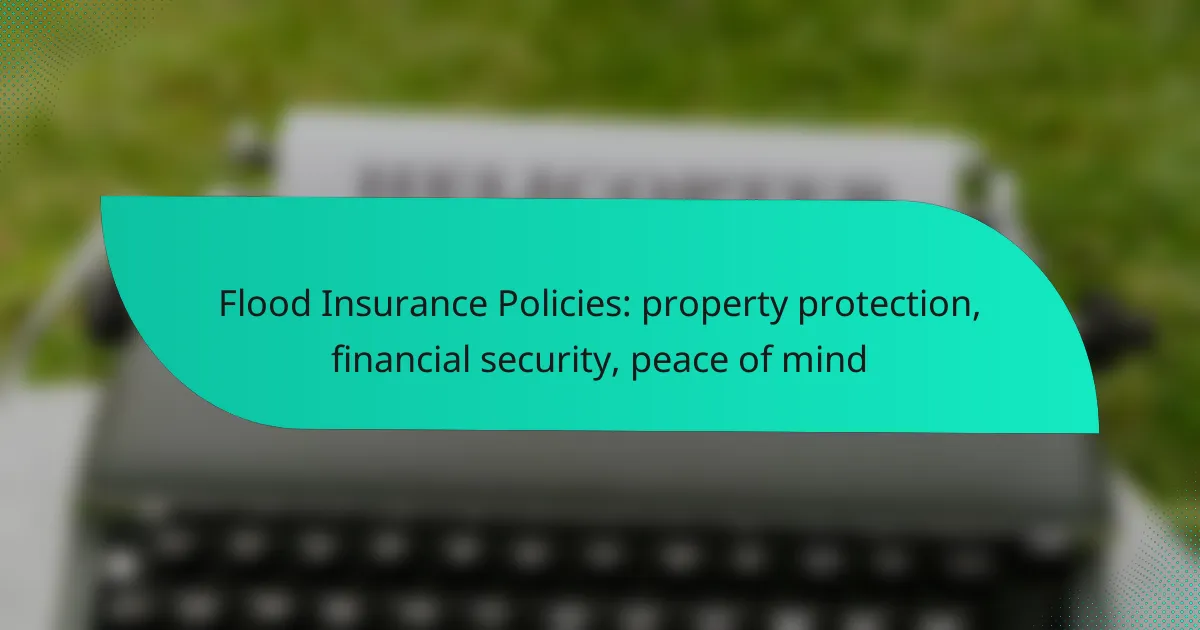Flood insurance policies are crucial for safeguarding your property and ensuring financial security in the face of potential flooding. By covering damages to both the structure and contents of your home, these policies provide peace of mind, allowing homeowners to better prepare for and respond to flood events. Understanding the options available, including those through the National Flood Insurance Program and private insurers, is essential for effective flood protection.

What are the benefits of flood insurance policies?
Flood insurance policies provide essential protection for property, financial security for homeowners, and peace of mind during flood events. These benefits help mitigate the risks associated with water damage, ensuring that homeowners are better prepared for potential flooding scenarios.
Property protection against water damage
Flood insurance policies specifically cover damages caused by flooding, which is often excluded from standard homeowners insurance. This coverage can protect your home and personal belongings from significant water damage, which can lead to costly repairs. For instance, if your home is in a flood-prone area, having flood insurance can save you from paying thousands of dollars out of pocket.
When selecting a flood insurance policy, consider the coverage limits and the types of damages included. Policies typically cover the structure of your home, as well as personal property such as furniture and appliances. Review your policy to ensure it meets your specific needs, especially if you have valuable items that require additional coverage.
Financial security for homeowners
Having flood insurance provides financial security by reducing the risk of unexpected expenses related to flood damage. Without this coverage, homeowners may face substantial repair costs that could lead to financial strain or even bankruptcy. Flood insurance can help you recover more quickly, allowing you to focus on rebuilding rather than worrying about finances.
In many areas, especially those prone to flooding, federal disaster assistance may not fully cover the costs of damage. Flood insurance can bridge this gap, ensuring that you receive adequate compensation for repairs and losses. It’s crucial to assess your financial situation and consider flood insurance as a necessary investment for long-term security.
Peace of mind during flood events
Flood insurance offers peace of mind by allowing homeowners to feel secure knowing they are protected against potential flooding. This assurance can alleviate stress during heavy rainstorms or when flood warnings are issued. With the right coverage, you can focus on safety and preparedness rather than worrying about the financial implications of a flood.
Additionally, many flood insurance policies include resources and support for homeowners during a flood event, such as guidance on filing claims and emergency response. This support can be invaluable in navigating the aftermath of a flood, making the recovery process smoother and less daunting.
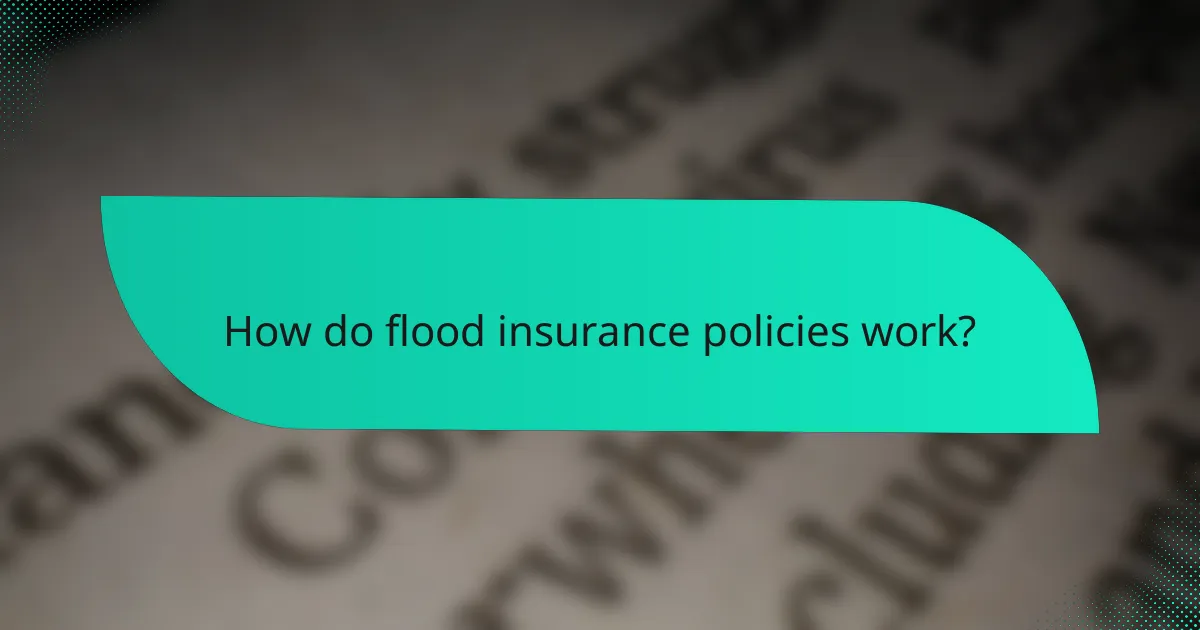
How do flood insurance policies work?
Flood insurance policies provide financial protection against damages caused by flooding. They typically cover the structure of your home and its contents, helping to mitigate the financial impact of flood-related losses.
Coverage details and exclusions
Flood insurance generally covers damage to your home and personal belongings caused by flooding from various sources, such as heavy rain, storm surges, or overflowing rivers. However, there are exclusions to be aware of, including damage from sewer backups unless specific coverage is added.
Common coverage limits for residential properties range from tens of thousands to several hundred thousand dollars, depending on the policy. It’s essential to review your policy details to understand what is included and any additional endorsements you may need for comprehensive protection.
Claim process overview
The claim process for flood insurance typically begins by reporting the damage to your insurance provider as soon as possible. You will need to document the damage with photographs and provide a detailed inventory of lost or damaged items.
After filing a claim, an adjuster will assess the damage and determine the payout based on your policy limits and coverage. It’s crucial to keep records of all communications and follow up regularly to ensure your claim is processed efficiently.

What types of flood insurance policies are available in the US?
In the US, there are primarily two types of flood insurance policies: those offered through the National Flood Insurance Program (NFIP) and private flood insurance options. Each type has distinct features, coverage limits, and eligibility requirements that property owners should consider when seeking flood protection.
National Flood Insurance Program (NFIP)
The NFIP, managed by FEMA, provides federally backed flood insurance to property owners in participating communities. Policies typically cover both building and personal property, with coverage limits of up to $250,000 for structures and $100,000 for contents.
To obtain NFIP coverage, homeowners must live in a community that participates in the program and must pay an annual premium based on factors such as the property’s flood risk and location. It’s important to note that there is usually a 30-day waiting period before coverage takes effect, so planning ahead is crucial.
Private flood insurance options
Private flood insurance policies are offered by various insurance companies and can provide more flexible coverage than NFIP policies. These options may cover additional risks, such as basement flooding or higher coverage limits, and can be tailored to meet specific needs.
When considering private flood insurance, it’s essential to compare different providers and policies, as coverage terms and premiums can vary significantly. Some private insurers may also offer quicker activation of coverage, which can be beneficial in urgent situations.

How to choose the right flood insurance policy?
Choosing the right flood insurance policy involves assessing your property’s risk factors and comparing various policy costs and coverage options. Understanding these elements helps ensure adequate protection and financial security in the event of flooding.
Assessing property risk factors
To assess your property’s risk factors, consider its location, elevation, and proximity to water sources. Properties in flood-prone areas or those with lower elevations typically face higher risks and may require more comprehensive coverage.
Additionally, review historical flood data for your area and consult local flood maps. This information can help you determine the likelihood of flooding and guide your decision on the necessary level of coverage.
Comparing policy costs and coverage
When comparing flood insurance policies, look at both the premium costs and the coverage limits. Premiums can vary significantly based on factors like location and property value, often ranging from a few hundred to several thousand dollars annually.
Examine the specifics of what each policy covers, including structural damage, personal property, and additional living expenses. Some policies may offer optional endorsements for added protection, which can enhance your peace of mind but may also increase costs.

What are the costs associated with flood insurance?
The costs of flood insurance can vary significantly based on location, property characteristics, and coverage levels. Homeowners in flood-prone areas often face higher premiums, which are essential for protecting their properties and ensuring financial security against flood damage.
Average premiums in flood-prone areas
In flood-prone areas, average flood insurance premiums typically range from a few hundred to several thousand dollars annually. For example, homeowners may pay anywhere from $500 to $2,000 per year, depending on the flood zone and property specifics. Properties in high-risk zones, classified as Special Flood Hazard Areas (SFHAs), generally incur higher costs.
Additionally, the National Flood Insurance Program (NFIP) provides a standard policy that can help homeowners estimate their premiums based on their property’s elevation and risk level. Understanding these averages can aid in budgeting for necessary coverage.
Factors influencing insurance rates
Several key factors influence flood insurance rates, including the property’s location, elevation, and construction type. Homes situated in high-risk flood zones face significantly higher premiums than those in lower-risk areas. Elevation above the Base Flood Elevation (BFE) can lead to reduced rates, as higher properties are less likely to sustain flood damage.
Other considerations include the age of the home, its foundation type, and the presence of flood mitigation measures, such as levees or flood vents. Homeowners should regularly review their policies and consider these factors to ensure they are getting the best coverage at a reasonable price.
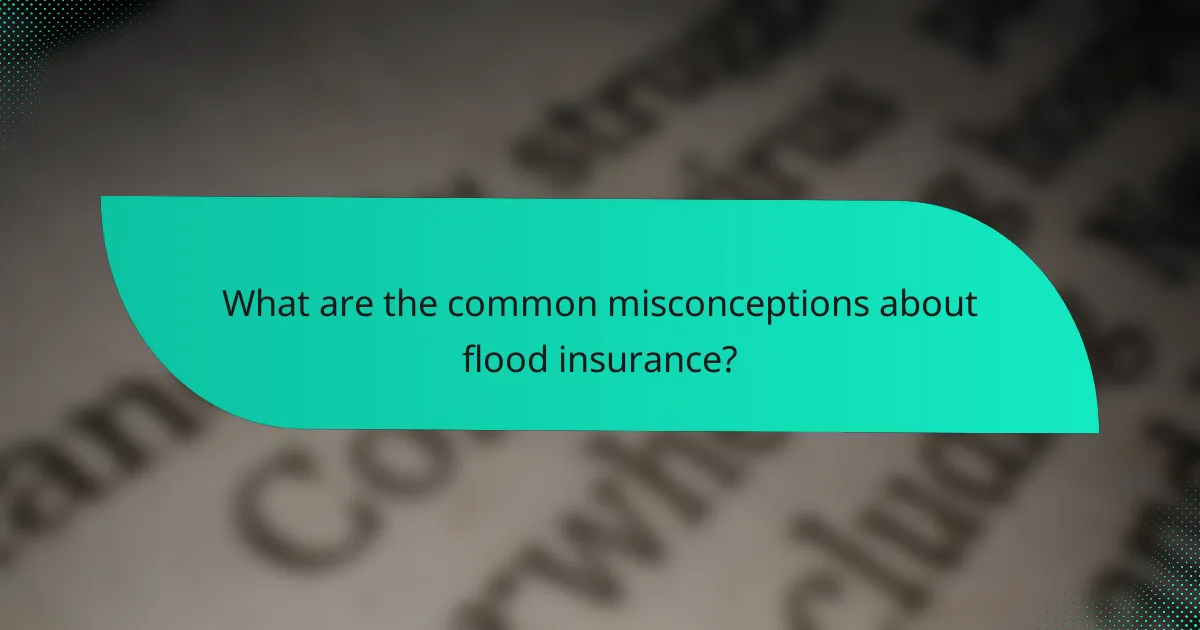
What are the common misconceptions about flood insurance?
Many people misunderstand flood insurance, believing it covers all types of water damage or is included in standard homeowners policies. In reality, flood insurance is a specific policy that protects against damage from flooding, which is distinct from other water-related issues.
Flood insurance covers all water damage
A common misconception is that flood insurance protects against all forms of water damage, including leaks and sewer backups. However, flood insurance specifically covers damage caused by rising water, such as from heavy rainfall or storm surges.
For example, if a pipe bursts in your home, that damage would typically fall under homeowners insurance, not flood insurance. It’s crucial to understand the specific terms of your policy to ensure adequate coverage for various types of water damage.
Homeowners insurance includes flood coverage
Many homeowners mistakenly believe their standard homeowners insurance policy includes flood coverage. In most cases, this is not true; flood insurance must be purchased separately, often through the National Flood Insurance Program (NFIP) or private insurers.
To ensure you are protected, review your homeowners policy and consider adding flood insurance if you live in a flood-prone area. This additional coverage can provide financial security and peace of mind, especially in regions where flooding is a common risk.
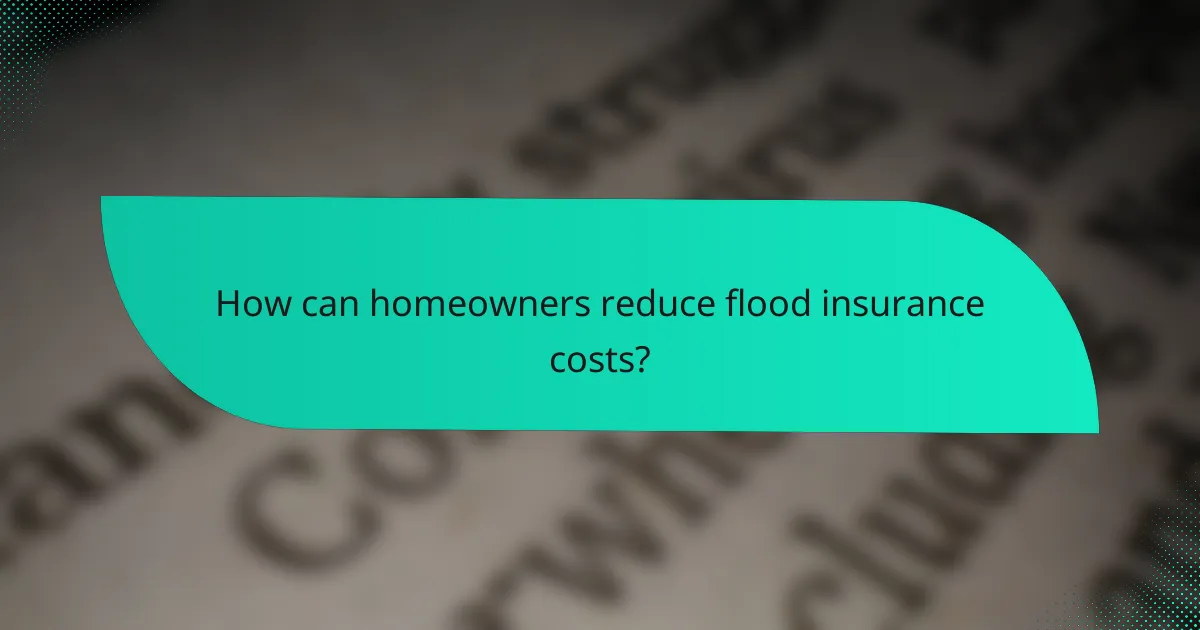
How can homeowners reduce flood insurance costs?
Homeowners can reduce flood insurance costs by implementing effective flood mitigation measures and opting for higher deductibles. These strategies not only lower premiums but also enhance property protection and financial security.
Implementing flood mitigation measures
Flood mitigation measures help minimize the risk of flood damage, which can lead to lower insurance premiums. Homeowners can invest in improvements such as elevating the property, installing flood barriers, or using water-resistant materials in construction.
Additionally, maintaining proper drainage systems and landscaping can redirect water away from the home. Many insurance providers offer discounts for homes that have taken proactive steps to reduce flood risks, making these measures financially beneficial in the long run.
Choosing higher deductibles
Selecting a higher deductible on a flood insurance policy can significantly lower monthly premiums. Homeowners should consider their financial situation and ability to cover the deductible in the event of a claim.
For example, increasing the deductible from $1,000 to $2,500 may reduce premiums by a notable percentage. However, it’s crucial to ensure that the chosen deductible is manageable, as it directly impacts out-of-pocket costs during a flood event.
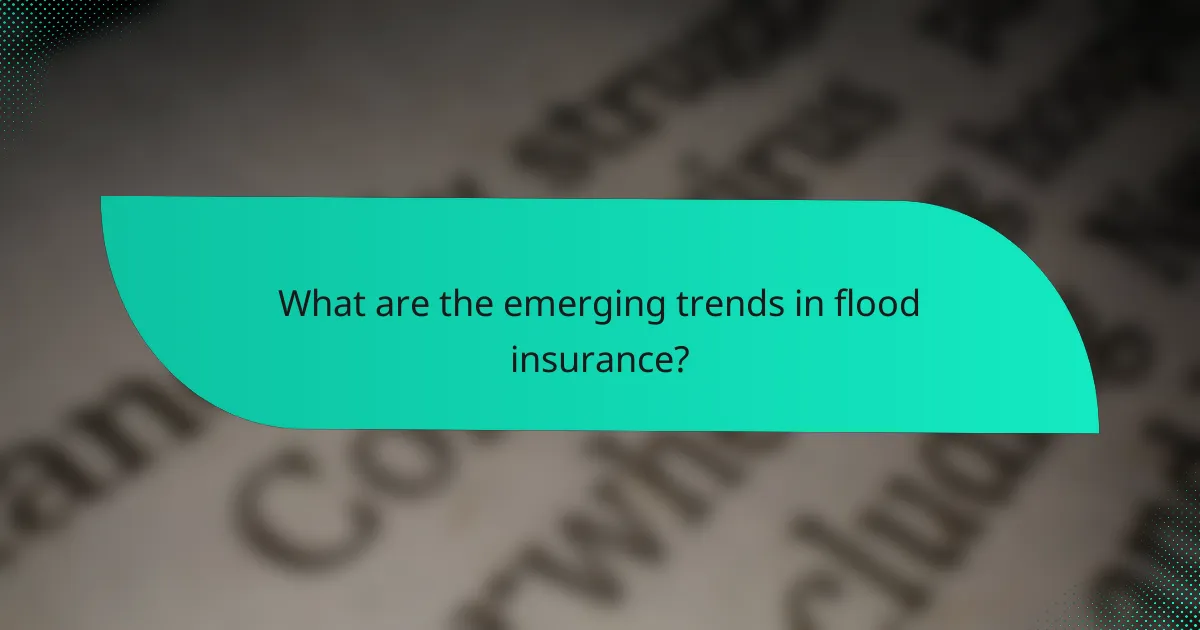
What are the emerging trends in flood insurance?
Emerging trends in flood insurance focus on enhanced technology use, personalized policies, and increased awareness of climate risks. These trends aim to improve property protection, financial security, and peace of mind for policyholders.
Increased adoption of technology in claims processing
The integration of technology in flood insurance claims processing is transforming how claims are handled. Insurers are now utilizing digital platforms and mobile applications to streamline the submission and tracking of claims, making the process faster and more efficient.
For example, some companies are employing artificial intelligence to assess damages through photos submitted by policyholders. This can reduce the time it takes to process claims from weeks to just a few days, providing quicker financial relief to those affected by flooding.
Policyholders should ensure they are familiar with their insurer’s technology offerings, such as mobile apps or online portals, to maximize the benefits of these advancements. Being proactive in understanding these tools can lead to a smoother claims experience and faster payouts.
